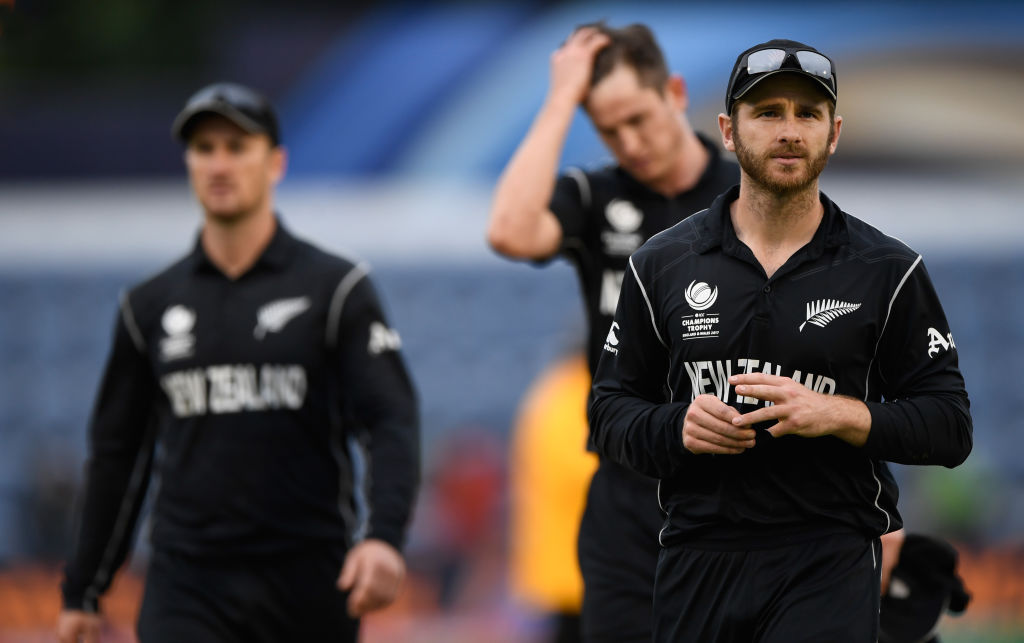Planet Cricket: Black Caps slipping up in the one-day stakes despite Williamson’s invaluable leadership

CARDIFF, WALES - JUNE 09: New Zealand captain Kane Williamson leads his team off the field after the ICC Champions Trophy match between New Zealand and Bangladesh at SWALEC Stadium on June 9, 2017 in Cardiff, Wales. (Photo by Stu Forster/Getty Images)
(Photo: Getty Images)
By Tim Wigmore
In the 2015 World Cup, New Zealand were intoxicating and unmissable. It was not merely the eight straight games they won, but the élan and joie de vivre of their cricket. The land of dour cricket and the dibbly-dobbler medium pacer was transformed into being at the cutting edge of the world game.
Well, not anymore. New Zealand’s meek exit from the Champions Trophy, for all the brilliance of the 224-run stand between Mahmudullah and Shakib Al Hasan, was sadly in keeping with their ODI cricket in recent months. If the World Cup was a perfect storm, a side encompassing 11 players in form, the Champions Trophy was a throwback to New Zealand sides of yore, in which a coterie of fine players received mediocre support from a clutch of supporting players short of the requisite class.
Pity poor Kane Williamson. The finest batsman New Zealand have ever produced was magnificent, scoring 252 runs in three innings, all of them made in his wonderfully unobtrusive, understated manner.
In every game Williamson ensured that New Zealand had a supreme platform. They were 254-3 off 39 overs against Australia; 158-2 off 30 overs against England; and 152-2 in the 30th over against Bangladesh.
On every occasion, Williamson’s dismissal – twice to a run-out, once to Mark Wood’s jaffa – precipitated a meek collapse. Against Australia, New Zealand responded to Williamson’s wicket with a collapse of 7-37 in six overs, a performance so ignominious that New Zealand were bowled out with an over of their innings remaining.
Against England, 7-55 in 10.5 overs followed Williamson’s wicket. Against Bangladesh the collapse was delayed, but it still came, after Ross Taylor was dismissed, New Zealand lost 5-64 in the last 11.3 overs.
Nestled in these lamentable performances was an uncomfortable truth: New Zealand now appear as reliant on Williamson as the West Indies used to be upon Brian Lara. As the Champions Trophy showed, Williamson’s runs emphatically bring no guarantees of New Zealand success; his failures, though, virtually ensure New Zealand flounder. When he failed in two matches against South Africa, it led to calamitous collapses to 112 and 149 all out.
George Headley, the magnificent West Indies batsman of the Thirties who was nicknamed ‘Atlas’, such was the way he carried the side, lamented how his teammates squandered their wickets with reckless shots: “Why him don’t like to bat?” As Williamson saw all his sterling work rendered futile, he could have felt entitled to ask the same.
Experienced high-class players Martin Guptill and Ross Taylor both failed to match the standard set by Williamson: Guptill squandered bright starts in every match; Taylor scored 148 runs, but his strike rate – just 74.37 – was almost funereal by the standards of the modern ODI game, putting too much pressure on those around him.
Those supporting acts sadly proved themselves not up to the job. Luke Ronchi is averaging 15.25 since the World Cup. Jimmy Neesham and Corey Anderson, expected to provide power at six and seven, instead contributed a combined 65 runs at 10.83 apiece in the Champions Trophy.
And Neil Broom, recalled at No. 5 – the position from which Grant Elliot anchored New Zealand’s World Cup semi-final win over South Africa – looked like a batsman who averaged 25.23 in Division Two County Championship cricket for Derbyshire last year.
New Zealand’s bowling was almost as lop-sided. Twice they took three wickets within the opening ten overs. But when the ball lost its swing, the bowlers lost their threat. Sharing the fifth bowler duties, Anderson and Neesham were both ineffectual. Spinner Mitchell Santner never threatened, taking only a solitary wicket in the tournament; his selection ahead of Jeetan Patel was defensive.
Even the wicket-taking pace bowlers were less than outstanding. When returning for their second and third spells, they seemed markedly less effectual. In truth neither Trent Boult nor Tim Southee have developed quite as envisaged since the World Cup. They are skilful and admirable international bowlers, but they are not quite of the first rank: a metaphor for New Zealand’s wider team.
As their players trudged off at Cardiff, the sense was unmistakeable. New Zealand’s ranking of fourth, with which they entered the tournament, was a better reflection of past glories than future successes; indeed, they have already slipped to fifth. Even with Williamson unerring in his run-making, New Zealand are regressing to a level that, historically, has been their mean.
Playing the blame game is easy, and perhaps more heed could have been given to regenerating the team after 2015, rather than depending on underperforming 30-somethings like Ronchi and Broom. But the prosaic truth might simply be that, given their small population and limited playing pool – only 50 per cent more than Scotland’s – New Zealand’s decline is exactly what we should expect.